高中英语Module4WhichEnglishSectionⅢGrammar_复习状语和状语从句教学案外研版选修
- 格式:doc
- 大小:164.50 KB
- 文档页数:10
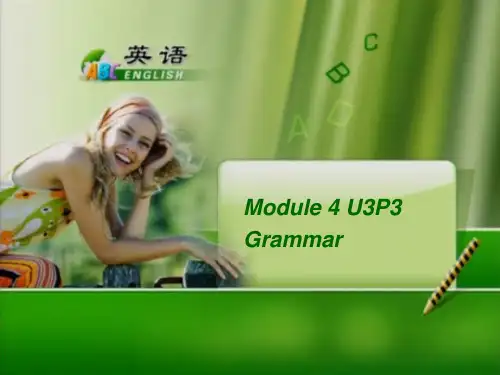
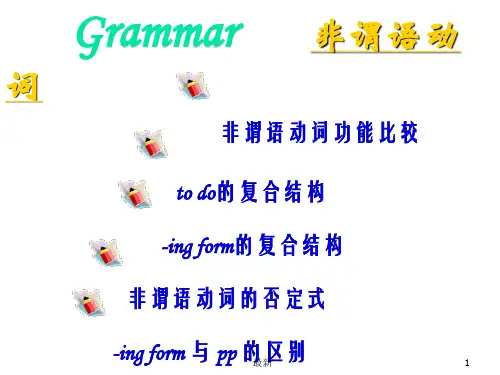
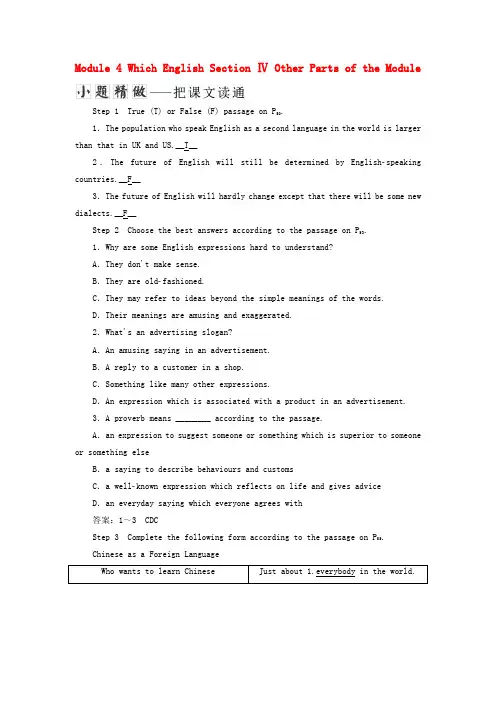
Module 4 Which English Section Ⅳ Other Parts of the ModuleStep 1 True (T) or False (F) passage on P50.1.The population who speak English as a second language in the world is larger than that in UK and US.__T__2.The future of English will still be dete rmined by Englishspeaking countries.__F__3.The future of English will hardly change except that there will be some new dialects.__F__Step 2 Choose the best answers according to the passage on P53.1.Why are some English expressions hard to understand?A.They don't make sense.B.They are oldfashioned.C.They may refer to ideas beyond the simple meanings of the words.D.Their meanings are amusing and exaggerated.2.What's an advertising slogan?A.An amusing saying in an advertisement.B.A reply to a customer in a shop.C.Something like many other expressions.D.An expression which is associated with a product in an advertisement.3.A proverb means ________ according to the passage.A.an expression to suggest someone or something which is superior to someone or something elseB.a saying to describe behaviours and customsC.a wellknown expression which reflects on life and gives adviceD.an everyday saying which everyone agrees with答案:1~3 CDCStep 3 Complete the following form according to the passage on P55.Chinese as a Foreign Language一、这样记单词二、这样记短语1.(教材P48)What does the man complain about? 这个人抱怨什么?complain v .抱怨;不满;投诉;控告市民抱怨说,由于空气污染,他们不能让窗户开着。

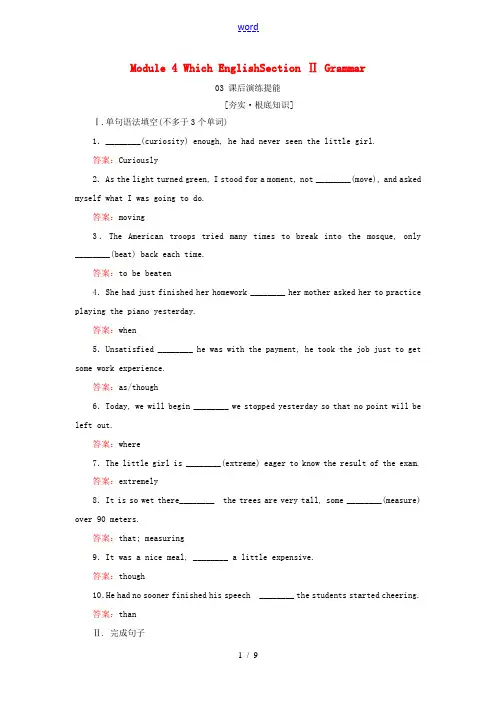
Module 4 Which EnglishSection Ⅱ Grammar03 课后演练提能[夯实·根底知识]Ⅰ.单句语法填空(不多于3个单词)1.________(curiosity) enough, he had never seen the little girl.答案:Curiously2.As the light turned green, I stood for a moment, not ________(move), and asked myself what I was going to do.答案:moving3.The American troops tried many times to break into the mosque, only ________(beat) back each time.答案:to be beaten4.She had just finished her homework ________ her mother asked her to practice playing the piano yesterday.答案:when5.Unsatisfied ________ he was with the payment, he took the job just to get some work experience.答案:as/though6.Today, we will begin ________ we stopped yesterday so that no point will be left out.答案:where7.The little girl is ________(extreme) eager to know the result of the exam.答案:extremely8.It is so wet there________ the trees are very tall, some ________(measure) over 90 meters.答案:that; measuring9.It was a nice meal, ________ a little expensive.答案:though10.He had no sooner finished his speech ________ the students started cheering.答案:thanⅡ. 完成句子1.正如所报道的那样,自从清华大学建校以来已有100多年时间了。

Module 4 Which EnglishSection ⅡGrammar--状语和状语从句[语法图解][典句感知]①It can sound very different from place to place.②For example, within London the most famous dialect is cockney.③One woman was lying in bed, awake.④A customer came up to the author holding a copy of the book and said Emma Chissit。
⑤The boy needs a pen to do his homework。
⑥We’ll start our project if the president agrees。
⑦I’ll give you an answer immediately I’ve finished reading the report.⑧The head of the company promised to deal with matters of this sort the moment he returned to his office。
⑨Poor as he was, he was honest。
[语法领悟](1)①~⑤句为词语作状语,⑥~⑨句为句子作状语。
(2)④⑤为非谓语动词作状语。
(3)⑥句中的条件状语从句用一般现在时代替一般将来时。
(4)⑦句用副词引导状语从句;⑧句用名词性短语引导时间状语从句。
(5)⑨句中的状语从句使用了倒装语序。
一、状语状语的位置和状语的构成状语是用来修饰动词、形容词、副词或整个句子的成分,一般表示时间、地点、方式、程度、原因、条件、目的、结果、让步、伴随情况等意义.状语在句中的位置比较灵活,修饰形容词的状语,通常放在所修饰的词之前;修饰动词的状语,一般放在所修饰的动词之后,但有些副词,如always, often, never等词作状语时,则放在实义动词之前,助动词、be动词或情态动词之后。

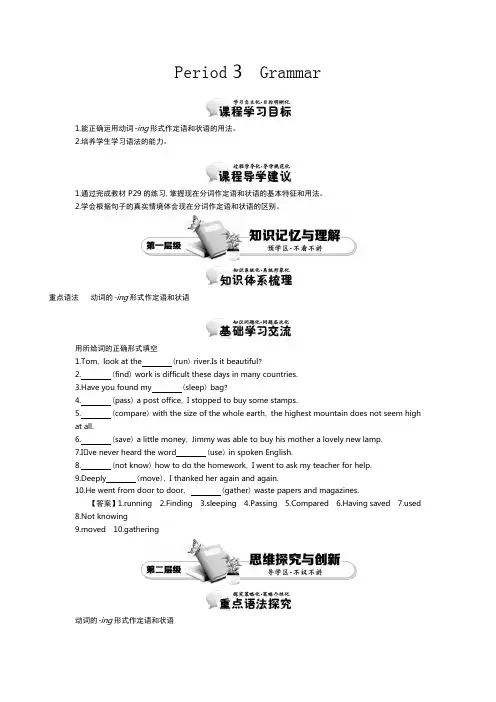
Period 3Grammar1.能正确运用动词-ing形式作定语和状语的用法。
2.培养学生学习语法的能力。
1.通过完成教材P29的练习,掌握现在分词作定语和状语的基本特征和用法。
2.学会根据句子的真实情境体会现在分词作定语和状语的区别。
重点语法动词的-ing形式作定语和状语用所给词的正确形式填空1.Tom, look at the(run) river.Is it beautiful?2.(find) work is difficult these days in many countries.3.Have you found my(sleep) bag?4.(pass) a post office, I stopped to buy some stamps.5.(compare) with the size of the whole earth, the highest mountain does not seem highat all.6.(save) a little money, Jimmy was able to buy his mother a lovely new lamp.7.I ve never heard the word(use) in spoken English.8.(not know) how to do the homework, I went to ask my teacher for help.9.Deeply(move), I thanked her again and again.10.He went from door to door,(gather) waste papers and magazines.【答案】1.running 2.Finding 3.sleeping 4.Passing pared 6.Having ed8.Not knowing9.moved10.gathering动词的-ing形式作定语和状语一、动词-ing形式作定语动名词作定语用来说明该名词的用途,不表示名词本身的动作;现在分词作定语与所修饰的名词具有逻辑上的主谓关系,即现在分词相当于所修饰名词的谓语。
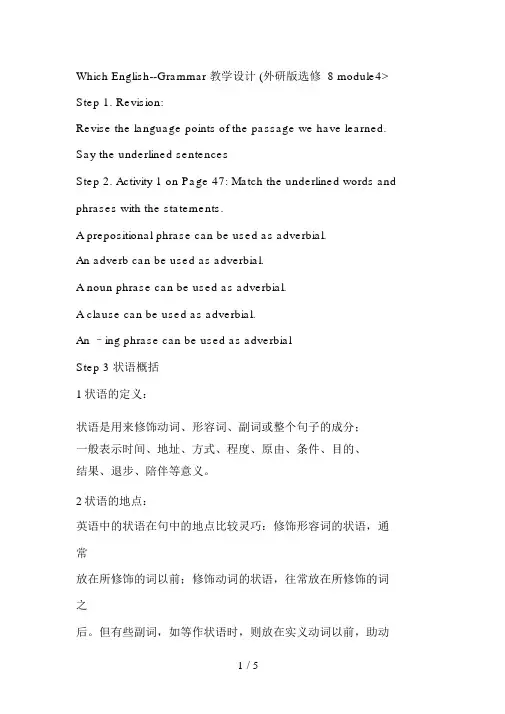
Which English--Grammar 教学设计 (外研版选修 8 module4> Step 1. Revision:Revise the language points of the passage we have learned. Say the underlined sentencesStep 2. Activity 1 on Page 47: Match the underlined words and phrases with the statements.A prepositional phrase can be used as adverbial.An adverb can be used as adverbial.A noun phrase can be used as adverbial.A clause can be used as adverbial.An –ing phrase can be used as adverbialStep 3 状语概括1状语的定义:状语是用来修饰动词、形容词、副词或整个句子的成分;一般表示时间、地址、方式、程度、原由、条件、目的、结果、退步、陪伴等意义。
2状语的地点:英语中的状语在句中的地点比较灵巧:修饰形容词的状语,通常放在所修饰的词以前;修饰动词的状语,往常放在所修饰的词之后。
但有些副词,如等作状语时,则放在实义动词以前,助动词、be 动词或神态动词以后。
3状语的组成:状语常由副词、形容词、介词词组、非谓语动词和状语从句、独立主格构造担当。
4状语的分类 :状语可分为十种:目的状语原由状语结果状语时间状语地址状语方式状语退步状语比较状语条件状语陪伴状语Step4. Activity 2: Work in pairs. Read the sentences in activity 1 againand answer the questions.1.Which adverbial is used to express result?2.Which adverbial is used to express manner?3.Which adverbial is used to express degree?4.Which adverbial is used to express place?5.Which adverbial is used to express cause?6.Which adverbial is used to express time?7.Which adverbial is used to express frequency?(1.> Ask the students to do this individually, then check withtheir partners.(2> Call back the answers from the whole class, having one studentread the question and another give the answer.Step5. Activity3 onP47(1.> Ask the students to do these sentences individually, then check with their partners.(2> Ask the students to answer the questions, reading the complete sentences. Step6状语从句概括1.状语从句可分为九种:目的状语从句原由状语从句结果状语从句时间状语从句地址状语从句方式状语从句退步状语从句比较状语从句条件状语从句2.常用连词:类别连词时间状语从when, whenever, while, as,句before,after,since,till,once, as soon as, etc.地址状语从where, wherever句原由状语从because, since, as, for, now句that, etc.目的状语从in order that, so that, that,句etc.结果状语从so that,so that,句such that, that, etc.条件状语从if, unless, as(so>long as,句etc.退步状语从though,although, even if,句even though, however,whatever, as, etc.比较状语从as as, so as, than, etc.句3.重点解说:方式状语从as, as if, as though, etc.句<1) A. while 指引的从句中谓语动词一定是可以持续的动词B.since 指引的从句用过去时,主句用此刻达成时。

Module 4 Which English Section Ⅲ Grammar-复习状语和状语从句语法图解探究发现①It can sound very different from place to place.②For example, within London the most famous dialect is cockney.③One woman was lying in bed, awake.④A customer came up to the author holding a copy of the book and said Emma Chissit.⑤The boy needs a pen to do his homework.⑥We'll start our project if the president agrees.⑦I'll give you an answer immediately I've finished reading the report.⑧The head of the company promised to deal with m atters of this sort the moment he returned to his office.⑨Poor as he was, he was honest.[我的发现](1)①~⑤句为词语作状语,⑥~⑨句为句子作状语。
(2)④⑤为非谓语动词作状语。
(3)⑥句中的条件状语从句用一般现在时代替一般将来时。
(4)⑦句用副词引导状语从句;⑧句用名词性短语引导时间状语从句。
(5)⑨句中的状语从句使用了倒装语序。
一、状语(一)概念修饰动词、形容词、副词以及全句的句子成分,叫作状语。
用作状语的通常是副词、介词短语、不定式和从句等。
状语一般放在被修饰的词之后或放在句尾。
副词作状语时可放在被修饰的词前或句首。
(二)不同形式的状语1.副词(短语)作状语The boy needs a pen very much.男孩非常需要一支钢笔。
(程度状语)The boy needs a pen now./Now the boy needs a pen./The boy now needs a pen.男孩现在需要一支钢笔。
(时间状语)2.介词短语作状语Before his mother Tom is always a boy.在母亲面前,汤姆总是个孩子。
(地点状语)On Sundays, there is no student in the classroom.星期天,教室里没有学生。
(时间状语)3.分词(短语)作状语He sits there, asking for a pen.他坐在那儿要一支笔。
(表示伴随状态)4.动词不定式作状语We were glad to hear that ShenzhouXⅠ had been sent up into space suc cessfully.听到神舟十一号成功发射的消息我们很高兴。
(原因状语)5.名词作状语Come this way!走这条路!(方式状语)I will be back next Monday.我下周一回来。
(时间状语)6.形容词作状语Tired and hot, we had to stop to have a break.又累又热,我们只好停下来休息。
(原因状语)(三)位置状语在句中的位置比较灵活。
一般来讲,多数状语都放在句子的后面。
修饰谓语动词的状语一般放在谓语的后面,若有宾语则放在宾语的后面。
修饰整个句子的状语则放在句子的最前面,并用逗号隔开。
但有些副词作状语则放在实义动词之前,助动词、be动词或情态动词之后,如always, often, usually, never, ever等。
She studies hard at school.她在学校努力学习。
She studies English very hard at school.她在学校学习英语很努力。
Unfortunately, he missed the train.不幸的是他未赶上火车。
He is always late for school.他总是上学迟到。
[即时演练1] 画出下列句子中的状语①It sounds very different from_place_to_place.②Full_of_hope,_the local people are working hard to_rebuild_their_hometown.③Having_lived_abroad_for_twenty_years,_the old man returned to his hometown where he was brought up.④I will stay another_five_months.⑤Heated,_water changes into steam.⑥In_spite_of_the_heavy_rain,_they arrived.⑦Always look your homework through before_handing_it_in.二、状语从句(一)状语从句的概念及分类用来修饰谓语动词、其他动词、定语、状语或整个句子的从句叫作状语从句。
可分为时间、条件、原因、让步、比较等状语从句。
(二)各种状语从句的具体用法1.时间状语从句时间状语从句常由以下引导词引导:when; while; as; before; after; since; until; as soon as; no sooner ...than ...; hardly ...when; the moment; every time; immediately等。
A.when, while, as引导的时间状语从句(1)when表示时间点时,从句中用短暂性动词;表示时间段时,用延续性动词。
You had already gone when I arrived there.当我到达时,你已经走了。
(when表示点时间)When I lived in the countryside,I used to carry some water for him.当时住在农村,我常常为他担水。
(when表示段时间)(2)while表示“在……期间”或“在某一段时间里”,它所引导的从句的动作是延续性的,并侧重表示和主句动作的同时发生。
Sam went through a magazine while he waited.萨姆一边等着一边翻阅杂志。
(3)as引导的时间状语从句①as表示从句的动作与主句的动作同时发生,一般与延续性动词连用。
As I watched them, an idea struck me.我看着他们时,产生了一个想法。
②as表示“一边……一边……”,强调从句和主句中两个动作交替进行或同步进行。
As the students walked to their dorms, they sang happily.学生们一边往宿舍走,一边快乐地唱着歌。
③as还可以说明两种正在发展或变化的情况,意为“随着”,表时间的推移。
As time goes on, it's getting warmer and warmer.随着时间的推移,天气变得越来越暖和了。
B.since引导的时间状语从句since表示从过去某一时间或动作、事情起到目前为止,意思是“自……以来”。
引导状语从句时,主句用现在完成时或现在完成进行时,since从句中一般用短暂性动词的一般过去时。
We've been friends ever since we met at school.自从我们在学校认识之后,我们就一直是好朋友。
C.before, after引导的时间状语从句(1)before表示在一段时间之前。
after表示在一段时间之后。
I had written my dissertation before my supervisor went abroad.在导师出国之前,我已完成了我的学位论文。
I found your coat after you had left the house.你离开房子之后,我发现了你的外衣。
(2)before有时翻译成“……才……”,“不到……就”,“趁……就”,“还没(来得及)……就”。
It was quite a few years before he finally finished his novel.过了好几年他才完成他的小说。
He ran off before I could stop him.我还没来得及阻止他,他就跑掉了。
D.till, until引导的时间状语从句(1)如果主句的谓语动词是延续性动词,就常用肯定式表示“直到……为止”;如果主句的谓语动词是瞬间动词,就常用否定表示“直到……才”。
He will remain in college until (till)he finishes his Ph. D course.他将留在学校里面直到完成他的博士学位课程。
I didn't wake up until I heard the alarm clock.直到听到闹钟的铃声我才醒来。
(2)当not until位于句首时,主句中的主语、谓语要使用倒装语序。
Not until he came back did I leave.直到他回来我才走。
[名师点津] ①until引导的从句可以放在主句之前或主句之后,但till从句一般不放在句首。
②在强调句型中一般只能用until,不用till。
It was not until she took off her dark glasses that I recognized her.直到她摘下墨镜,我才认出她来。
E.表示“一……就……”的时间状语从句as soon as, once, immediately, instantly, directly, the moment, the minute, the instant, the second, no sooner ...than, hardly ... when, scarcely ...when等引导的从句都表示从句的动作一发生,主句的动作随即就发生了,即“一……就……”。
As soon as we got home, the telephone rang.我们刚到家,电话就响了。
He said he'd turn on TV the moment he got home.他说他一回到家就打开电视机。